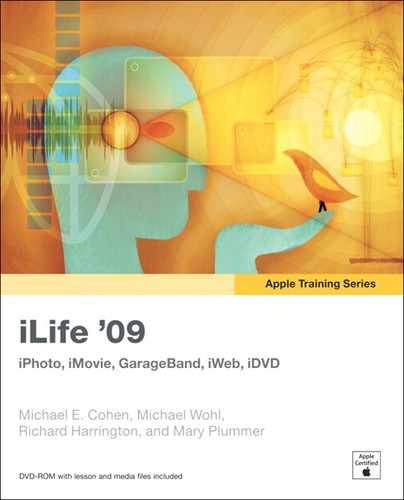
6 Importing and Organizing Your Photos
Also keep in mind that sometimes it’s okay for part of your subject to fall out-
side the frame. Using a close shot that omits part of the subject can add visual
interest as well.
Grasping the Technical Details
Three factors combine to affect the quality of the image your camera produces:
resolution, exposure, and aperture.
Resolution
Each digital picture consists of thousands of individual colored dots, called
pixels (short for picture elements). The number of pixels that make up the pic-
ture is known as the picture’s resolution. The more pixels, the more detail in
the picture; the fewer pixels, the more fuzzy or ragged the picture looks.

Grasping the Technical Details 7
Digital cameras are often rated by how many millions of pixels (megapixels)
they can provide. Two or three megapixels is sufficient to produce attractive
snapshots and more than sufficient for pictures on a webpage. You need more
megapixels for high-quality full-page pictures in a print publication. However,
the more megapixels your camera provides, the more storage space each pic-
ture takes up in the camera’s memory and on your Mac’s hard disk.
A very low-resolution picture
Although the maximum resolution is determined by your camera’s optics and
can’t be changed, you can set many cameras to use a lower resolution to con-
serve storage space.
Exposure
To capture a picture, your camera briefly opens a shutter to allow the light
that makes up the picture to enter the camera. This length of time is called
the exposure and is usually measured in fractions of a second. The longer the
exposure, the more light is captured, but the greater the chance that a small
movement of the camera or your picture’s subject will cause the image to
appear blurred.
Long exposures are useful when shooting in low light, but such pictures
require a steady hand (or the use of a tripod) and a stationary subject. Short

8 Importing and Organizing Your Photos
exposures are usually required for action shots, such as sports photos, but
short exposures need a lot of light to illuminate the subject. Many digital
cameras can artificially boost their sensitivity to light to compensate for short
exposures in low light; however, such pictures may look grainy because of the
electronic “noise” that the boost in sensitivity can create.
Pictures taken in very low light look grainy
Aperture
How wide the camera’s shutter opens when you take a picture is called its aper-
ture setting. The wider the aperture, the more light that can enter the camera
when the shutter opens. The exposure and the aperture settings together con-
trol how much light a picture captures: A wide aperture with a short exposure
lets in the same amount of light as a long exposure and a narrow aperture.
The aperture, however, also controls depth of field, the distance between the
closest and most distant objects in the picture that are in focus. A narrow
aperture gives a wide depth of field, whereas a wide aperture produces a more
narrow depth of field.
Digital cameras usually set aperture and exposure automatically. However, you
can also adjust these settings manually for greater control with many cameras.
If your camera allows you to adjust these settings, experiment with them to
learn how each affects the quality of your pictures.
Grasping the Technical Details 9
Choosing a Shooting Format
Some cameras offer you a choice between two image formats: JPEG and RAW.
JPEG (which stands for Joint Photographic Experts Group) is a format that
reduces the amount of information that makes up a picture. It throws away
information that the eye ordinarily can’t discern, and uses sophisticated meth-
ods to compress the information that does remain so that you can fit more
images into the camera’s storage.
RAW pictures, on the other hand, retain nearly all of the information that
came into the camera when you took them. As a result, RAW images take up
considerably more storage space than their JPEG-compressed equivalents:
often as much as 10 to 15 times as much storage. The advantage of RAW pic-
tures is that they offer you much finer control when you modify them with
image editing tools, such as the ones that iPhoto provides.
For casual photography, or to conserve storage space on your camera or your
Mac, you can use the JPEG format with no qualms. Many digital cameras, in
fact, offer only the JPEG format.
However, if you plan to make professional use of your pictures, or if you want
to have the maximum amount of control when you fine-tune your images, you
should consider the RAW format. Just make sure you have plenty of storage
space available.
Capturing GPS Data
Courtesy of the U.S. Department of Defense, dozens of satellites circle Earth as
part of the Global Positioning System, commonly known as GPS. These satellites
broadcast microwave signals that terrestrial devices can use to pinpoint their loca-
tions. The system is used by aircraft, automobile navigation systems, and even digi-
tal cameras, such as the one included in the iPhone 3G.
If you have a camera that includes GPS capability, the camera can obtain a
precise record of where a picture is taken, and it can store that location infor-
mation in the picture itself.
Usually, because the GPS receiver in a camera can use up a significant amount
of battery power, the GPS receiver can be turned on or off at your discretion.
..................Content has been hidden....................
You can't read the all page of ebook, please click here login for view all page.
